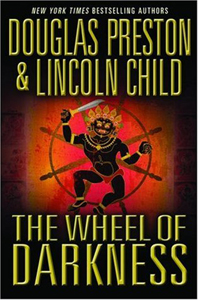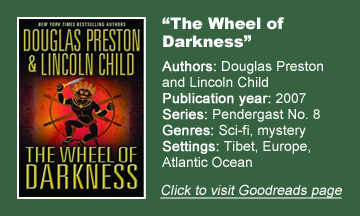Past and present collide as Agent Pendergast and Constance hit the high seas in a nod to the 1912 Titanic tragedy in Douglas Preston and Lincoln Child’s “The Wheel of Darkness” (2007). In their eighth Pendergast novel, the authors hint at future scientific discoveries by looking into ancient Buddhist mysticism, going right up to the line between science fiction and supernatural fantasy (it’s up to the reader to decide if they cross it).
The concept of people being possessed by an ancient drawing is admittedly not something you find in every novel, but it’s also kind of silly – and yet it is entertaining to see Pendergast’s personality change. “Wheel” is not the authors’ A-game, but it does provide plenty of talking points.
A modern Titanic
The Britannia is the modern answer to the Titanic, filled with things that seemingly should not exist on a passenger liner. Able to carry 4,000 people, the ship’s size is staggering, and it features promenades and movie theaters and lavish two-story staterooms.
Pendergast, with his endlessly deep pockets, secures a mid-level berth on the maiden transatlantic voyage for himself and Constance at the last moment so they can pursue the murderer and thief of a Buddhist parchment known as the Agozyen.
The ship reminds me of the massive sea-floor structure in Child’s “Deep Storm,” which came out the same year. But fine restaurants and shops at the sea floor are weirder than on a ship, so “Wheel” can’t compete there; P&C fans perhaps prefer whichever of the contemporaneous novels they read first.
Mystery not what it could be
The mystery is not what it could be. P&C try for an Agatha Christie approach of introducing suspects at the first shipboard dinner, but they don’t follow through.
In one mid-book chapter, a girl is introduced to the reader for the sake of becoming the unknown killer’s latest victim. She says “It’s you!” upon being attacked, but we have no way to know which suspects she knows, so we miss out on the guessing game. In the end, Pendergast explains who the killer(s) were, and I still didn’t quite get it.
This is because the killer appears to be a smoke monster, like from “Lost,” and ultimately not explained much better than in that TV series. This is where P&C push the science-fiction/supernatural border.
Tapping into magic
Admittedly, it made me look forward to the epilog, in which Pendergast explains that the manipulative parchment meets at the intersection of mathematics and brain waves. He paraphrases Arthur C. Clarke and notes that anything we don’t understand looks like magic, but it can ultimately be explained by science — even if we don’t yet understand the specifics.
At first, I was like “OK, guys, whatever.” But since I’ve already bought into Constance Greene being more than a century old but being physiologically 20 or so, it would be hypocritical of me to dismiss an entity created via mental concentration.
Some of the things these Tibetan monks do – including one who lives his whole life in a small room, contemplating the universe – are so amazing that it becomes plausible that heretofore unknown human mental achievements could come about.
Uncompleted ideas
What I’ve described so far is enough for a novel, but “Wheel” is further overstuffed with uncompleted ideas. Constance gets a peek at how the other half lives when she goes undercover as a maid; in contrast to the lavish above-deck quarters, the ship’s low-level staffers live in cramped dorms – that hasn’t changed in the century since the Titanic. But she wraps her investigation quickly.
Later, we’re introduced to high-tech bubbles that could allow people to safely abandon the out-of-control ship. But the authors forget about the devices and focus on the lifeboats, which can’t be launched when the ship is at full speed.
In the finale, one of the two threads outstrips the other. An under-the-influence Pendergast undergoes a personality change and it’s highly entertaining to watch Constance react to his bizarre behavior.
New mistakes for a new age
But more time is spent on the possessed Britannia captain – locked in the bridge — guiding the ship toward the Carrion Rocks of the Grand Banks (this story’s answer to Titanic’s iceberg), and the other officials’ attempts to stop her. This can’t compete for our attention with Pendergast acting weird, even if it is the more crucial part of the plot.
I do like how the Britannia addresses the Titanic’s mistakes — there are more than enough lifeboats this time — and yet the higher technology is what causes the problems as soon as an unanticipated factor enters the equation. Ironically, the anti-terrorist locks protect the terrorist.
Also including humor (the embarrassing items in rich passengers’ safes) and fun (Pendergast offhandedly breaks up a card-counting ring in the casino), “The Wheel of Darkness” is an entertaining-in-the-moment novel. But it’s too all over the place to be a great one.



